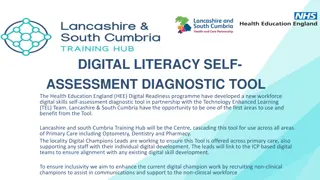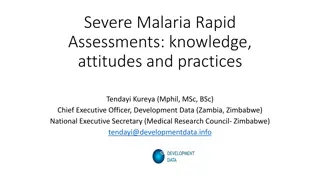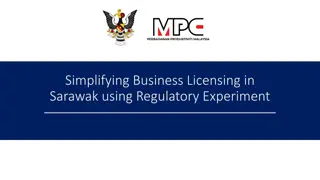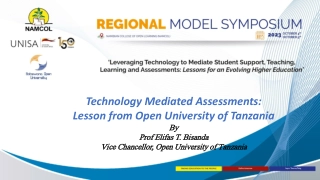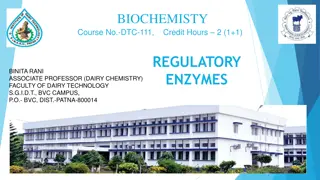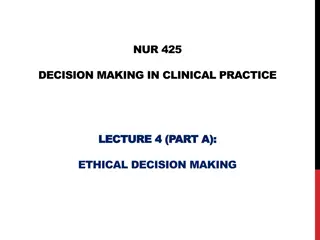Digital Health Technology-Derived Clinical Outcome Assessments in Regulatory Decision-Making
This session discusses the landscape of DHT-derived novel endpoints in clinical research, focusing on considerations for regulatory decision-making. It explains the use of digital health technology in clinical outcome assessments and highlights the potential benefits of digitally collected COAs, such as remote data capture and improved inclusivity in clinical trials.
Download Presentation

Please find below an Image/Link to download the presentation.
The content on the website is provided AS IS for your information and personal use only. It may not be sold, licensed, or shared on other websites without obtaining consent from the author. Download presentation by click this link. If you encounter any issues during the download, it is possible that the publisher has removed the file from their server.
E N D
Presentation Transcript
July 27, 2021 Session I: DHT-Derived Novel Endpoint Development: Current Landscape Elektra Papadopoulos, FDA/CDER Lindsay Kehoe, CTTI Brian Perry, CTTI
Digital health technology-derived clinical outcome assessments: considerations for regulatory decision-making Elektra Papadopoulos, MD, MPH Acting Deputy Director Division of Clinical Outcome Assessment Office of New Drugs, CDER, FDA
Disclaimer Views expressed in this presentation are those of the speaker and do not necessarily represent an official FDA position. 3
What is a digital health technology (DHT)? A system that uses computing platforms, connectivity, software, and/or sensors for healthcare and related uses. These technologies span a wide range of uses, from applications in general wellness to applications as a medical device. They include technologies intended for use as a medical product, in a medical product, or as an adjunct to other medical products (devices, drugs, and biologics). They may also be used to develop or study medical products. SOURCE: BEST (Biomarkers, EndpointS and Other Tools): https://www.ncbi.nlm.nih.gov/books/NBK326791/ 4
We are focusing on digitally collected clinical outcome assessments (COAs): Clinical outcome: An outcome that describes or reflects how an individual feels, functions or survives. Measured using COAs. Digital health technologies can be used in assessments of: Biomarker: A defined characteristic that is measured as an indicator of normal biological processes, pathogenic processes, or biological responses to an exposure or intervention, including therapeutic interventions. SOURCE: BEST (Biomarkers, EndpointS and Other Tools): https://www.ncbi.nlm.nih.gov/books/NBK326791/
An example from PRO Consortiums Chronic Heart Failure Working Group 6 12th Annual PRO Consortium Workshop (April 14-15, 2021)
Potential benefits of digital health technology-derived COAs By enabling remote data capture Endpoints that matter to patients in daily life (e.g., patients experiences between clinic visits) Reduced participation burden/fewer barriers to clinical trial participation (e.g., travel) More inclusive and generalizable trials 7
What does it mean for a DHT-derived COA endpoint to be fit-for-purpose*? Overall considerations same as with any COA: Appropriate for its intended use e.g., Study design Patient population Validly and reliably measure a concept that is Clinically relevant Important to patients Able to show change within the clinical trial Can be communicated in labeling in a way that is accurate, interpretable, and not misleading (i.e., well-defined), if appropriately applied *Fit-for-purpose: A conclusion that the level of validation of a biomarker or COA is sufficient to support its proposed use. 8
Roadmap to patient-focused outcome measurement still applies 9
Were still in the early stages Limited experience in aggregating and summarizing continuously collected DHT data into a clinically meaningful endpoint Methodological issues include (but are not limited to): Defining activity parameters Determining appropriate assessment periods in a day Assessing minimal wear time requirements during a day Collecting and aggregating potentially large volumes of data to derive a score Defining the endpoint Interpreting the data, including meaningful within-patient change Handling missing data 10
In closing, Think with the end in mind: What is the overall COA measurement strategy? What role does the DHT-derived endpoint play and how will it complement other measures/endpoints? What parameters are most meaningful to assess? How will the DHT derived endpoint be defined? How will the benefit be described to stakeholders? Leverage recommendations and resources available Engage with FDA early and often 11
Helpful resources Patient-Focused Drug Development Guidance Series: https://www.fda.gov/drugs/development-approval-process-drugs/fda-patient-focused-drug- development-guidance-series-enhancing-incorporation-patients-voice-medical Drug Development Tool Qualification process guidance: https://www.fda.gov/regulatory-information/search-fda-guidance-documents/qualification- process-drug-development-tools-guidance-industry-and-fda-staff FDA COA Qualification Program Website: https://www.fda.gov/drugs/drug-development-tool-ddt-qualification-programs/clinical- outcome-assessment-coa-qualification-program Critical Path Institute s Patient-Reported Outcome Consortium Annual Workshop https://c-path.org/12th-annual-patient-reported-outcome-consortium-workshop/ FDA guidance on regulatory requirements for record keeping, maintenance, and access (21 CFR Part 11) https://www.fda.gov/media/75414/download 12
July 27, 2021 Resources to Support Novel Endpoint Development Lindsay Kehoe, Project Manager, CTTI
Disclaimer The views and opinions expressed in this presentation are those of the individual presenter and do not necessarily reflect the views of the Clinical Trials Transformation Initiative. The presenter is an Employee of Duke University. Salary support comes from pooled membership fees of the Clinical Trials Transformation Initiative and from FDA Cooperative agreement.
DHT-Derived Endpoints in Pivotal Trials: Where Are We? VISIBILITY Peak of Inflated Expectations Plateau of Productivity Slope of Enlightenment Trough of Disillusionment TIME Technology Trigger https://www.gartner.com/en/documents/3887767
DHT-Derived Endpoints In Use Today No known clinical outcome assessments captured by a DHT have been accepted by FDA to support an approved label claim As of June 2021, there are 200+ DHT-derived endpoints listed in Digital Medicine Society s crowdsourced Library of Digital Endpoints. 19 listed as primary endpoint in either phase 2 or phase 3 67 listed as secondary endpoint in either phase 2 or phase 3 8 DHT-Passive Monitoring COAs have an accepted Letter of Intent 7 qualified Clinical Outcome Assessments (COA) under the DDT program All are PROs
CTTIs Digital Health Trials (DHT) Program* PURPOSE: Develop evidence-based recommendations that affect the widespread adoption and use of digital health technology in clinical trials for regulatory submission. ANTICIPATED IMPACT: Increased number of clinical trials leveraging digital health technologies. More efficient trials generating better quality information. DHT Program Digital Health Technologies Novel Endpoints Decentralized Clinical Trials Engaging Patients & Sites 2018 2019 2017 2018 *Formerly CTTI s Mobile Clinical Trials (MCT) Program
CTTIs 2017 Developing Novel Endpoints Work Optimizing Novel Endpoint Selection Focus on measures that are meaningful to patients. Select the technology after selecting an outcome assessment. Use a systematic approach to identify key novel endpoints. Practical Approaches to Novel Endpoint Development Foster collaboration among key stakeholders. Create technical standards for mobile technology-derived assessments. Engage with regulators. Include novel endpoints as exploratory endpoints in existing clinical trials and observational cohort studies. Think critically about how to optimally position novel endpoints in interventional trials. Additional information at https://www.ctti-clinicaltrials.org/projects/novel-endpoints
CTTIs 2017 Developing Novel Endpoints Work Steps for Novel Endpoint Development
Project Overview Purpose: Obtain reliability and acceptance of meaningful, DHT- derived novel endpoints Objectives: Identify gaps and barriers and solutions to achieve regulatory acceptance for a DHT-derived endpoint Create a glossary for DHT-derived novel endpoints Describe the evidence needed to achieve regulatory acceptance for a novel, DHT-derived endpoint Expected Impact: Increase the use of meaningful, DHT-derived novel endpoints as key endpoints in clinical trials for labeling claims
Project Scope & Deliverables IN SCOPE OUT OF SCOPE Multi- Stakeholder Meeting Interview Results Clinical Outcome Assessments (COAs)* Functional outcomes Passive and active monitoring Technology intended for use in clinical trials Surveys (ePROs) Digital therapeutics Biomarkers Team Discussion & Consensus CTTI Recommendations *Per FDA/NIH s BEST glossary, a clinical outcome describes or reflects how an individual feels, functions or survives.
2021 Novel Endpoints Acceptance Project Team Team Leaders Team Members Alicia Staley (Medidata) Elektra Papodopoulous (FDA) J rg Goldhahn (ETH Zurich) Rodrigo Garcia* (EMD Serono) Kai Langel (Janssen) Tom Switzer (Genentech) Jeremy Wyatt (ActiGraph) Xinzhi Zhang (NIH) Andrew Potter (FDA) Sue Jane Wang (FDA) Maria Ali (George Institute for Global Health) Shelly Barnes (UCB) Steven Berman (FDA) Krishna Jhaveri (Phillips) Joy Bhosai (Duke) Matthew Diamond (FDA) Katy Eichinger (University of Rochester) Jeffrey Statland (KUMC) Michelle Crouthamel (AbbVie) Phil Green (patient) Emily Cerciello (Crohn's & Colitis Foundation) Timothy Chen (Medidata) Sonja Cloosterman (Orikami) Andy Coravos (HumanFirst) Megan Doyle (Amgen) Cynthia Geoghegan (patient) Beatrix Friedeberg (Amgen) Elizabeth Kunkoski (FDA) Ingrid Oakley-Girvan (Medable) Lauren Oliva (Biogen) Colleen Rouse (Cleveland Clinic) *Now Quentin Le Masne (EMD Serono) Social Science Lead Brian Perry (CTTI) Project Manager Lindsay Kehoe (CTTI)
Pathways for FDA Engagement for Drug Development Meetings (e.g., Critical Path Innovation Meetings) IND/NDA/BLA Pathway DDT COA Qualification Pathway Outside of an individual drug development program Outside of an individual drug development program Within an individual drug development program Informal, nonbinding meetings Development of novel COAs for use in multiple drug development programs addressing unmet measurement needs Investigational New Drug (IND) submissions to FDA Potential for general CDER advice on specific methodology or technology (e.g., COAs, biomarkers) Potential to support regulatory decision- making (within the individual drug development program) Potential to result in qualification of COA
Example Frameworks for DHT-Derived Endpoint Development FDA s Roadmap to Patient- Focused Outcome Measurement in Clinical Trials Digital Medicine Society s V3 CTTI s Steps to Novel Endpoint Development 2015 2017 2020
@CTTI_Trials Lindsay Kehoe, CTTI Project Manager Lindsay.kehoe@duke.edu THANK YOU www.ctti-clinicaltrials.org
July 27, 2021 Barriers to and Recommendations for Adoption of DHT-derived Endpoints: Review of CTTI s Current Novel Endpoint Project Results Brian Perry, Social Science Lead, CTTI
In-Depth Interviews with Sponsors Trial Selection Criteria a clinical trial that uses a digitally derived endpoint to support or potentially support a label claim the digitally derived endpoint uses a digital tool to objectively measure a functional clinical outcome Focused on digitally derived endpoint positioned as either primary or secondary Objectives Describe the evidence used to support DHT- derived novel endpoints in pivotal trials for successful regulatory approvals. Identify gaps, barriers, and solutions to using DHT-derived novel endpoints as key endpoints in pivotal clinical trials.
Interview Participants: Demographics 11 interviews: 10 different industry sponsor organizations Primarily large-sized companies (market cap > $10 billion) 20 participants total Majority of sponsor companies reported few to no other known uses of DHT-derived endpoints as primary or secondary outcomes w/in their organization
Clinical Trials Described (1) Regulatory Submission Futility of investigational product Yes No Ongoing Endpoint position by trial phase n (%) 2 (18) Observational 0 2 1 1 3 (27) Phase 2 0 3 0 3 1 (9) Exploratory endpoint 0 1 0 1 2 (18) Primary or secondary endpoint 0 2 0 2 5 (45) Phase 3 0 5 1 4 1 (9) Exploratory endpoint 0 1 0 1 4 (36) Primary or secondary endpoint 0 4 1 3 1 (9) Phase 4 1* 0 0 0 1 (9) Primary or secondary endpoint 1 0 0 0 * Endpoint has been accepted in Europe only
Clinical Trials Described (2) Therapeutic areas included: neurology (5) pulmonology (2) rare disease (2) orthopedics (1) cardiology (1) DHTs used ranged from technologies that are widely available for consumer use to those intended just for clinical trial purposes
Topics Addressed in CTTI-led Sponsor Interviews Endpoint selection process DHT selection process Validation process Regulatory interactions and feedback Recommendations from sponsors
Sponsor Uncertainty Barrier What evidence do regulators expect? How can the development process be streamlined based on existing evidence and context of use? Can DHT-derived endpoints be used across other therapeutic areas? Do DHT-derived endpoints need to be comparable to existing legacy COA? What DHTs are appropriate to use? What COA development frameworks are appropriate? Recommendation Engage patients, caregivers, clinicians, and regulators early and often throughout the process
Qualification Process is Too Burdensome Barrier Clinical Outcome Assessment Qualification process is too tedious to invest in Current rate of DHT innovation outpaces regulatory review Risk of investing in developing DHT-derived endpoint outweighs the benefits
Qualification Process is Too Burdensome Recommendation Include DHT endpoints in early phase trials Select DHT that is fit-for-purpose ensure: There is a need for a DHT-derived endpoint The DHT is verified and validated for context of use The DHT is sensitive to measure meaningful differences
Lack of Appropriate DHTs & Experienced Vendors Barrier Limited availability of cleared DHT for COI/COU Limited availability of experienced DHT vendors to assist with clinical trial operations Recommendation Build partnerships with DHT manufacturers Analytically validate DHT algorithm as needed for COU Discuss with regulators about need Work with DHT manufacturer and/or other experts to develop appropriate algorithm, if necessary
DHT-Derived Endpoint Information is Not Shared Barrier Information about DHT-derived endpoints used in trials is not readily shared Algorithms and validation findings are considered proprietary Suggestion Participate in and contribute toward external collaborations Share trial results regardless of outcome
Interpretation of Meaningful Change is Challenging Barrier How do you demonstrate the DHT-derived endpoint is clinically meaningful if there is no direct legacy COA to anchor it to? Effect size?
Interpretation of Meaningful Change is Challenging Recommendation Include DHT endpoints in early phase trials and observational studies To inform optimal balance of data sufficiency while also limiting patient burden Compare DHT-derived endpoints in healthy volunteers to patient population; and/or patients with varying degree of disease severity Monitor patient compliance throughout the trial Include PROs and ObsRO to provide context for DHT use as well as direct measure of how change in endpoint is affecting patients
Basic Evidence Required DHT is accurate and reliable for a specific outcome within a similar context of use as the trial DHT is safe and feasible to use as intended by the patient population Endpoint is measuring a health concept that is meaningful Endpoint is able to measure change in disease progression or therapeutic effectiveness Change is similar (but not the same) to changes in legacy COAs Change is meaningful to patients, caregivers, and/or clinicians
Reflections from the Clinical Path Innovation Meeting (CPIM) July 16, 2021








